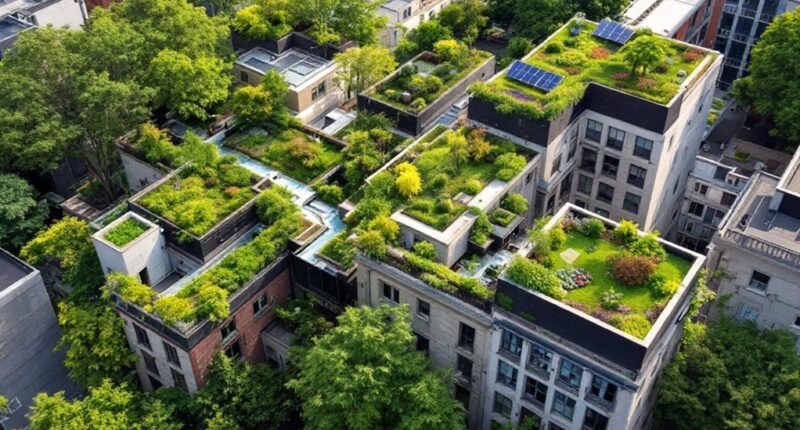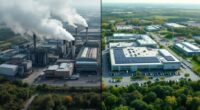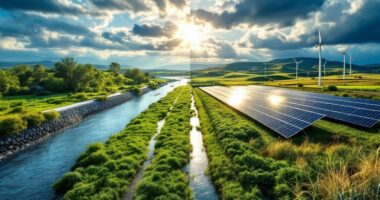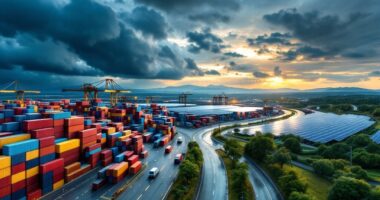Green infrastructure integrates natural elements like parks, green roofs, and rain gardens into urban areas, functioning like a Swiss Army knife for city challenges. These systems absorb rainwater like sponges, cool neighborhoods naturally, and create habitats for wildlife while costing less than traditional gray infrastructure. Benefits extend beyond environmental improvements—property values increase, energy costs decrease, and communities enjoy better mental health and stronger social bonds. The journey toward greener cities promises a triple win for people, planet, and prosperity.

Cities’ concrete jungles, once celebrated as triumphs of human engineering, are increasingly being reimagined through the strategic integration of green infrastructure. This network of natural and semi-natural elements—think parks that double as flood basins or rooftops sprouting more vegetation than a nature documentary—is revolutionizing urban planning. It’s nature’s cheat code for cities struggling with climate change, offering solutions that concrete simply can’t match.
Green infrastructure works like nature’s Swiss Army knife, tackling multiple urban challenges simultaneously. When a rainstorm hits, traditional infrastructure panics and floods, while green systems casually absorb the water like a sponge at a spill convention. During heatwaves, while concrete amplifies heat like a vengeful ex, green roofs and urban forests cool neighborhoods naturally—no air conditioning bill required. Innovative solutions like rain gardens and bioswales effectively capture pollutants and sediments, creating habitats for wildlife while reducing surface water pollution. Resources like the Minnesota Stormwater Manual provide comprehensive guidance on implementing these solutions for stormwater management and pollution control.
Nature doesn’t just survive in cities—it solves urban problems with elegant efficiency while concrete infrastructure throws a tantrum.
The economic perks are nothing to sneeze at (unless you’re allergic to savings). Green infrastructure typically costs less to implement than its gray counterparts, while simultaneously boosting property values. It’s like buying a car that pays you to drive it. Cities report lower energy costs, reduced flood damage, and new jobs in the “make-things-greener” sector.
Perhaps most impressive is the human factor. Research shows that access to green spaces improves mental health faster than a therapist with an espresso machine. Crime rates drop in greener neighborhoods, physical activity increases, and communities develop stronger social bonds—turns out people like chatting near trees more than beside storm drains.
Implementation isn’t without challenges. Funding constraints, institutional silos, and equitable distribution concerns can trip up even the greenest intentions. But innovative financing mechanisms, collaborative governance approaches, and community engagement strategies are helping cities overcome these hurdles.
Urban planners are increasingly treating green infrastructure not as decoration but as essential urban anatomy. By mimicking natural processes while delivering vital services, these systems are helping transform urban areas from environmental villains to sustainability heroes. In the battle against climate change, cities are discovering that sometimes the best technology isn’t technology at all—it’s nature.
Frequently Asked Questions
How Much Does Green Infrastructure Cost Compared to Traditional Systems?
Green infrastructure typically costs 30-60% less to construct than traditional systems.
Over a 50-year lifespan, green solutions average 23% cheaper thanks to lower maintenance and operational expenses. Specific costs vary—bioretention systems run $5-60 per square foot, permeable pavement $2-15, and green roofs $8-50.
The real financial win comes from multiple benefits: reduced flooding, lower treatment costs, and increased property values that traditional gray infrastructure simply can’t match.
What Skills Are Needed to Maintain Urban Green Infrastructure?
Maintaining urban green infrastructure requires a diverse skill set. Professionals need horticultural knowledge for plant care and soil management, alongside stormwater expertise to handle drainage systems and erosion control.
Technical proficiency with specialized equipment and digital mapping tools is essential. Environmental awareness, including ecosystem dynamics and invasive species management, rounds out the necessary capabilities.
Safety knowledge—from chemical handling to hazard mitigation—ensures proper maintenance while adhering to regulations and best practices for these natural urban systems.
Can Green Infrastructure Be Integrated Into Existing Urban Developments?
Green infrastructure can indeed be integrated into existing urban developments through strategic retrofitting. Cities can incorporate permeable pavements during street repairs, convert rooftops into green spaces, and transform vacant lots into pocket parks.
While challenges include limited space, high costs, and utility conflicts, successful integration often involves piggybacking on scheduled maintenance, creating incentive programs, and forming public-private partnerships. When thoughtfully implemented, these natural systems reduce stormwater runoff while enhancing property values and community wellbeing.
How Quickly Do Green Infrastructure Projects Show Measurable Benefits?
Green infrastructure projects deliver benefits at varying speeds, like a multi-course meal rather than a single dish. Some advantages appear immediately—stormwater reduction after the first rainfall and noise reduction right after installation.
Within 1-2 years, water quality improvements and biodiversity increases become evident.
Medium-term benefits (2-5 years) include flood risk reduction and habitat connectivity, while long-term advantages like climate resilience and significant ecosystem service value require 5-10 years to fully materialize.
Which Green Infrastructure Solutions Work Best in Arid Climates?
In arid climates, rainwater harvesting systems shine as top performers, capturing precious rainfall for later use. Bioswales and rain gardens featuring drought-tolerant native plants effectively manage occasional downpours while requiring minimal maintenance.
Permeable pavements reduce runoff and heat islands, particularly valuable in scorching urban environments. Green roofs using succulents and desert-adapted species provide insulation against extreme temperatures. These solutions work harmoniously with natural water patterns, turning water scarcity challenges into sustainable opportunities.









